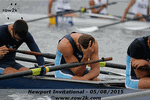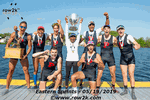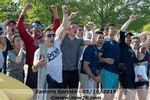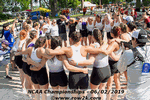Program Building Part 5 - Student Leadership
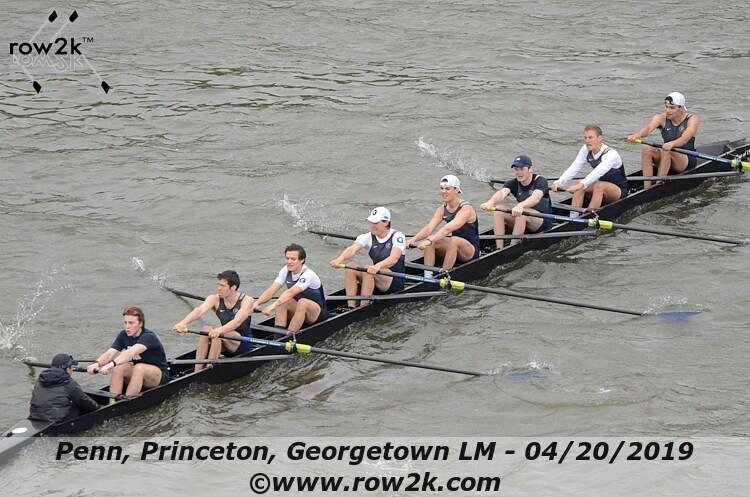
Following the cancellation of the 2020 spring racing season, row2k solicited the collegiate coaching community to engage in a variety of high-level topics within the profession. We submitted over sixty questions across a dozen topics and thank the coaches and staffs that found time to contribute their thoughts during this stressful time.
HOW DOES A STRONG TRADITION OF STUDENT LEADERSHIP GET BUILD AND MAINTAINED ON A TEAM, REGARDLESS OF HOW SUCCESSFUL THE TEAM IS ON THE WATER?
LEE RUMPF – GEORGETOWN LIGHTWEIGHT MEN
For strong leadership to be built there must be an understanding that holding a leadership role on the team is not just a figurehead position but that it actually means something. There must be a culture of active leadership opportunity for anyone who wants to step up and make a positive difference. Once that culture is in place and those athletes are allowed to take an active role in the direction/culture/feedback system of a team then maintaining it is all about tradition. Not in the sense of doing something because it was done before, but because of what it means to hold that position of leadership.
I like to think of team leaders as the storytellers of your program. It’s their responsibility to pass down to future generations the understanding of just how much work it takes to accomplish your goals and foster a positive team culture. Keeping that tradition alive is a great way to continue to foster strong leadership even during potential downswings in results.
YAZ FAROOQ – WASHINGTON WOMEN
I have relied heavily on our commodores and captains since the day I got here. There is a strong tradition of leadership and accountability that has been handed down from the generations that preceded this one and will carry on for many more to come. The Varsity Boat Club has been around for 110 years and each person who is elected by their peers is honored to serve. When people are inducted into the club their parents, alums and teammates are present. It’s unique to Washington and a very special night. We also have Class Leaders who help us make sure communication is clear at all levels and to let us know if anyone needs help.
ERIC GEHRKE – GEORGE WASHINGTON MEN
This goes back to an earlier answer that the coach creates and controls the ‘atmosphere’ of the team while the athletes control the ‘culture’. With that in mind, the student leadership is built and maintained in the understanding that they carry the structure of their culture on a daily basis. The student-athlete leadership is a lifestyle that needs to be lived in small ways every day, not just tapped into every once in a while, in meetings when we ask.
KEMP SAVAGE – EASTERN MICHIGAN
Establishing a place where your athletes can lead from their own strengths rather than just appointing the leaders you think are the best, gives your athletes different places where they can lead and develop their leadership. We have also added leadership from each class, Freshmen to Senior, that meets once a week to give each class a voice with the coaches. This allows our leaders to work with each other early in their career and allows our upperclassmen to mentor the underclassmen.
JAMIE FRANCIS – EMBRY RIDDLE
Part of that comes from recruiting; find the right people and you’ll have strong leaders. Part of that comes from how you structure your leadership team, providing opportunities for students to build on their leadership skills. We have been very fortunate to have great people on our team and many more leaders than we have captains. As we finish up our third year this year, we’ve laid the groundwork of what that leadership looks like on our campus and on our team.
BRIAN PERKINS – TEMPLE MEN
Empower the athletes that you trust. Make them part of an “in crowd” and hopefully it grows over time. But be prepared to replace those guys when they time out over four years. It takes courage and unselfishness to be a student leader: you move among your peers and there is really not much of a hierarchy in our sport. We have taken to having a vote for captains, then having each of the top five candidates write a short essay to tell us where the team will go under their leadership. The staff picks from there. This eliminates the popularity contest from captaincy, but the voting often shows us who the team trusts. If the staff is honest with the team, and the captains are trusted by the team, we have created a conduit of communication that hopefully strengthens the leadership positions on the squad.
ANONYMOUS HEAD COACH
Some leaders on a team will be vocal, some will set an example, other people may be encouragers, all will be critical to success. A critical role of the leadership on a team is to assist the coaching staff in the construction and protection of the culture by facilitating communication between the athletes and the coaching staff. But on a large team everyone on the team should be encouraged to find a leadership role. Empowering leaders in this fashion can be separate from success on the water.
SANDRA CHU – WILLIAM SMITH
I believe that there are two primary tenets of successful, strong and long-lasting student leadership. The first is to help student leaders move away from easy leadership and team clichés. Ideas don’t lead; actions do. So, we never talk about a value in our culture or of leaders without questioning what that looks like in real life. How would a stranger be able to tell that your team is committed if they saw your players at weights, on the water, in the library, in class, in the dining hall, on the weekend?

When your athletes can put actions to those situations that demonstrate their commitment; then you know that your students are leading themselves. When those behaviors become something that the team is proud of and can use in a description of themselves as a team—then you have a strong tradition of student leadership.
ETHAN SHOEMAKER – STETSON
I always say that winning is a side-effect, not an outcome, for a team. So, the first task of every leader on our team is to create a vision for what the team will look like 1-2 years into the future. After they have thought it through and can articulate that vision clearly, then we all get to work making that vision a reality. That includes me as the coach.
That vision is never about the races we win, but in fact about the way we treat one another, what our primary values are, how we approach our days together, even how we act outside of practice. So, our race results don’t define us. Sure, we get excited when we win, but we make sure that we are always thinking bigger than just the next race. In that way, leadership becomes bigger than our race performance. The two are no longer tied directly together.
COLIN FARRELL – PENN LIGHTWEIGHT MEN
I think that first, student leadership has to be allowed and encouraged. One of the things we moved towards on our team in the past few years was to take away the position of Captain. It seemed that position really created this situation where all the leadership was held by one or two athletes and everyone else had to work through that person. It ended up being a bad trade where we were getting good leadership from 1 or 2, but then more complacency from the other 40.
Instead we’ve worked at Penn to have more of a diffused leadership model. It takes some time for athletes to get their head around, but we really want everyone thinking and behaving as if they are the Captain. Everyone on our team has the opportunity to be a leader if they want to take it. I think leadership over time comes down to the athletes caring about the team, being invested in each other, buying in to what the program is all about, and as we said above, weathering and working through challenges.
The tradition of things comes down to younger athletes seeing older athletes take ownership and reap the benefits. And the benefits aren’t just on-water success, but also the level of engagement as well as self-satisfaction and the sense of achievement that comes from being highly invested in something and working hard to make it go. Isn’t that what sports are really all about? I think when underclassmen see that happening, it becomes inspiring for them to want to get there and be in a position where they can contribute to the team at a high level.
MARLEE BLUE – WASHINGTON WOMEN
A big thing is that there is tradition and structure behind our leadership. I also think our leadership is clearly labeled and created with everyone understanding their role. While everyone is a leader in their own way and by example, we have very clear roles that are voted for by the students that function the same way each year. I think this is essential.
For us, having an organized leadership group with many voices and scheduled meetings makes it hard for peoples’ thoughts or feelings to slip through the cracks. People have many avenues they can go through if they wish to have communication with any level of the team. I also think it cannot happen without the coaches. While so much of our leadership is run by the student athletes and centered on their independence, if there is not communication or trust between the coaches and the athletes everything will crumble.
A blanket open-door policy between athletes and coaches where an emphasis is put on accountability over consequences is the only way our team could be run. I think there also must be trust and agreement between coaches and staff. All of the coaches, strength and conditioning staff, doctors, trainers, and directors are on the same page with messaging and complete trust which I think really creates a basis for trust between the athletes and coaches.
CAMPBELL WOODS – MARIST MEN
Captain selection seems to be important to the athletes as these leaders really define who the crew puts up as their “ideal” athlete, so the coaches need to be mindful that the people in these positions MUST reflect the team culture that you want. Ultimately my biggest piece of advice here is to put the athletes in the driver’s seat. Our job, as coaches, is to develop a training program, organize the logistics of a season, maintain a competitive fleet and equipment, and recruit the best new athletes that we can. The coach can clearly define team culture and can use the process of selection to reinforce it but ultimately only the athletes can buy in and so the more things you can leave in their hands the better.

If you want them to behave like professionals, then they need to be treated that way. This doesn’t mean that they won’t occasionally need guidance, but the days of task master coaches cracking the whip until their teams succeed are largely over. These are smart young people who want a coach who is going to show them how to do this sport in the best possible way and so giving them the respect and dignity and space that they need to define themselves is essential.
When given this space the team is twice as likely to step up to the plate and enforce the team culture among themselves. When I started at Marist, we had whole boats of passengers who were just around to say they were on the team. This behavior has become unacceptable around our boathouse, but it didn’t happen overnight, and the change came from within the team with only consistent support and messaging from the coaches.
EMILIE GROSS – NORTH CAROLINA WOMEN
At Carolina we are so lucky to have a fantastic Leadership Academy that is available to all student-athletes. Here our student-athletes are able to learn how to lead as they are and add more tools to their toolkit throughout their time as a Carolina student-athlete. Which not only helps with our captain leadership and overall leadership, but it also helps our student-athletes once they move on beyond their 4 years at Carolina. For us it’s not just a 4-year commitment, it’s a lifetime.
ANONYMOUS HEAD COACH
To foster leadership, we try to prompt our athletes with topics or ideas they can run with and infuse into the team. I think though that at some point, on every team, the rowers have to decide what they want their experience to look like. You cannot win many races but have a great experience. You can win lots of races, but not enjoy what you are doing or who you do it with, though that is a little rarer. This is a tough question, but when a standard it set and held up by the leaders of a team, and that then becomes the expectation, that’s what drives and contributes to culture. We as coaches merely then just try to advise and guide and offer assistance along the way.
BART THOMPSON – ADRIAN
I think you start with giving underclassmen/younger rowers small roles of leadership on the team; maybe it’s leading stretching one day or asking them to speak up about their crew’s performance and what went well/poorly after a practice or race.
You also speak to your current team leaders and make sure that they’re reaching out and mentoring these younger rowers, teaching them what they know about successful leadership. As for succeeding with leadership whether or not the team is succeeding on the water, I think it goes back to being a process-oriented team. Some teams do not have the horsepower to win their conference; for that crew, finishing 3rd might be a huge accomplishment.

Not every team can win, but every team can push harder to be the best version of themselves. This is a double-edged sword, too, it’s not just crews that push to their limit and lose that get applauded—sometimes a winning crew that underperformed to their given ability will be critiqued. When that happens, the message becomes clear that it is about reaching one’s potential, not simply doing enough to win. And when that becomes a key objective then there is always something to push towards, even if you may not have the necessary speed to win a given race.
ALICEA STRODEL – MINNESOTA WOMEN
The University of Minnesota Athletic Department does a great job of fostering leadership through a series of coursework and events for student-athletes. It is consistent, strategic and very much impactful. This gives me, as a head coach, a foundation to build off of and specialize.
JOHN BOYD – IONA
In our program we like to have each individual on the team identify which areas of leadership they are particularly strong or weak in. In the end you find that there are several that fill each bucket and teaches them that they all bring something of value to the program instead of leadership always beginning and ending with the team captain(s).
BOB BRADY – FRANKLIN & MARSHALL
I tell our rowers that anyone can be a leader on the team, whether they have a leadership title or not. Now this doesn't mean I expect a freshman to come in and tell juniors and seniors what to do, but that first-year could lead by example, or find ways to push upperclassmen, or take initiative to get others to engage in extra workouts or team dinners. And if that sense of leadership can carry on over the years, others will feed off of it - it becomes contagious because others want to follow along or strive to find new ways to be a leader on the team.
TODD KENNETT – CORNELL HEAVYWEIGHT MEN
Some of my best teams there was a natural leader. Someone who you just wanted to row behind and follow to the end of the earth! That said, I do think you can help build and groom some leaders within your group. Usually in my experience it tends to be someone who was originally a follower, and who has longevity in the crew.
He/She has been there for many years, and each year they build their confidence and knowledge. Maybe their sophomore year they just made the boat and were happy to be in it, their junior year they started to really push the seniors or top people in the boat because they no longer are happy to be there but they want to win, and by their senior year, they want to win, but realize that not only do they have to have a great individual performance, but they need the others in the boat to do the same, and hopefully you have been working with them over that time to help them realize they can have influence and moments to help guide the group and become that leader you need to have success.
Occasionally, I have had individuals take the roll much faster, I guess they are naturals. So, I suppose it is natural ability, but I do think you can help to mold people into these roles. Part of it is the individuals being able to work with others and have fun while doing sadistic, boring, painful, work! One person can help but the other athletes have to buy in and start to pick up on the standard, and then also help to enforce it. Enforcing is a strong word, but that may not mean checking on rules, but rather doing the work to the standard required by the team, and then expecting it every day, and expecting it from those around them as well.
COLIN TRUEX – UC SAN DIEGO WOMEN
Empowered team leaders have been absolutely critical for our team success over the years. We are fortunate here at UCSD to have both an emerging leader’s development program as well as a leadership roundtable that consists of the leaders from many of the teams at UCSD. The leadership program not only teaches how to be good leaders (and followers) but also gives them the language and skills to be able to communicate through issues whether it is with each other or with the coaches. I think it is important to create and empower many levels of student leadership; so you have your formal leaders in the captains, but perhaps you have a coxswain captain, or your SAAC rep is an underclassmen. The more of the students that feel involved with the running of the team the more invested they become and the more you can count on them to push themselves and their teammates to maximum performance.
If you enjoy and rely on row2k, we need your help to be able to keep doing all this. Though row2k sometimes looks like a big, outside-funded operation, it mainly runs on enthusiasm and grit. Help us keep it coming, thank you! Learn more.
Comments | Log in to comment |
There are no Comments yet
| |
- Bont Rowing
- Calm Waters Rowing
- Concept 2
- Craftsbury Sculling
- The Crew Classic
- CrewLAB
- Croker
- Durham Boat Co.
- Empacher
- Faster Masters
- Filippi
- Fluidesign
- h2row.net
- HUDSON
- Live2Row Studios
- Nielsen-Kellerman
- Oak Ridge RA
- Peinert Boat Works
- Pocock Racing Shells
- Race1 USA
- RowKraft
- Rubini Jewelers
- Vespoli USA
- WinTech Racing
- Bont Rowing
- Calm Waters Rowing
- Concept 2
- Craftsbury Sculling
- The Crew Classic
- CrewLAB
- Croker
- Durham Boat Co.
- Empacher
- Faster Masters
- Filippi
- Fluidesign
- h2row.net
- HUDSON
- Live2Row Studios
- Nielsen-Kellerman
- Oak Ridge RA
- Peinert Boat Works
- Pocock Racing Shells
- Race1 USA
- RowKraft
- Rubini Jewelers
- Vespoli USA
- WinTech Racing






